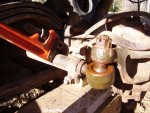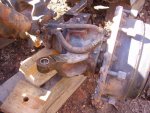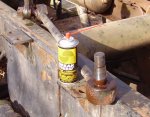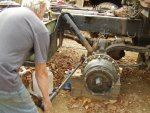I have my doubts about grease doing anything at all.
Look at the images below, the part of the ball becoming exposed when it's exercised is free of rust. That's how good the seal is along the lower edge (top edge in that image). Rust above, no rust below after 37 years. A hermetic seal couldn't do much better!
Soaking with CLP from this end may take a very long time, but I'm tempted to drill a very small hole in the top cover to see if the penetrant can do any better from the "top" end of the joint. Grease would only remain on top if a zerk fitting was installed. The movements of these joints are not very extensive.
Tight ball joints will result in the wheels not returning back to staright forward after a turn. The caster effect of the wheels will not work well and the result will be a driver effort to keep the vehicle straight, with or without power steering. A very exhausting task for the driver and even dangerous in some situations.
"Spoke" with Frank in Tulsa and he has tight ball joints as well, but lives with it. He only drives his XM757 in parades and such.
These joints are certainly not supposed to be tight. What would the reason be for that? The wheel hubs sitting on their kingpin bearings turn with finger pressure.
Some spec I have found for other ball joints call for about 5 ft-lb of torque to turn, mine are a whopping 70 ft-lb!
They must have been sweet coming off the assembly line, probably as near perfect as can be.
One reason, according to David D, that this series of 5-tonners didn't become the new standard for the Army was that they were cost prohibitive. With some of the technology I have seen so far, I can understand that.
Stay tuned, this problem will be solved.








